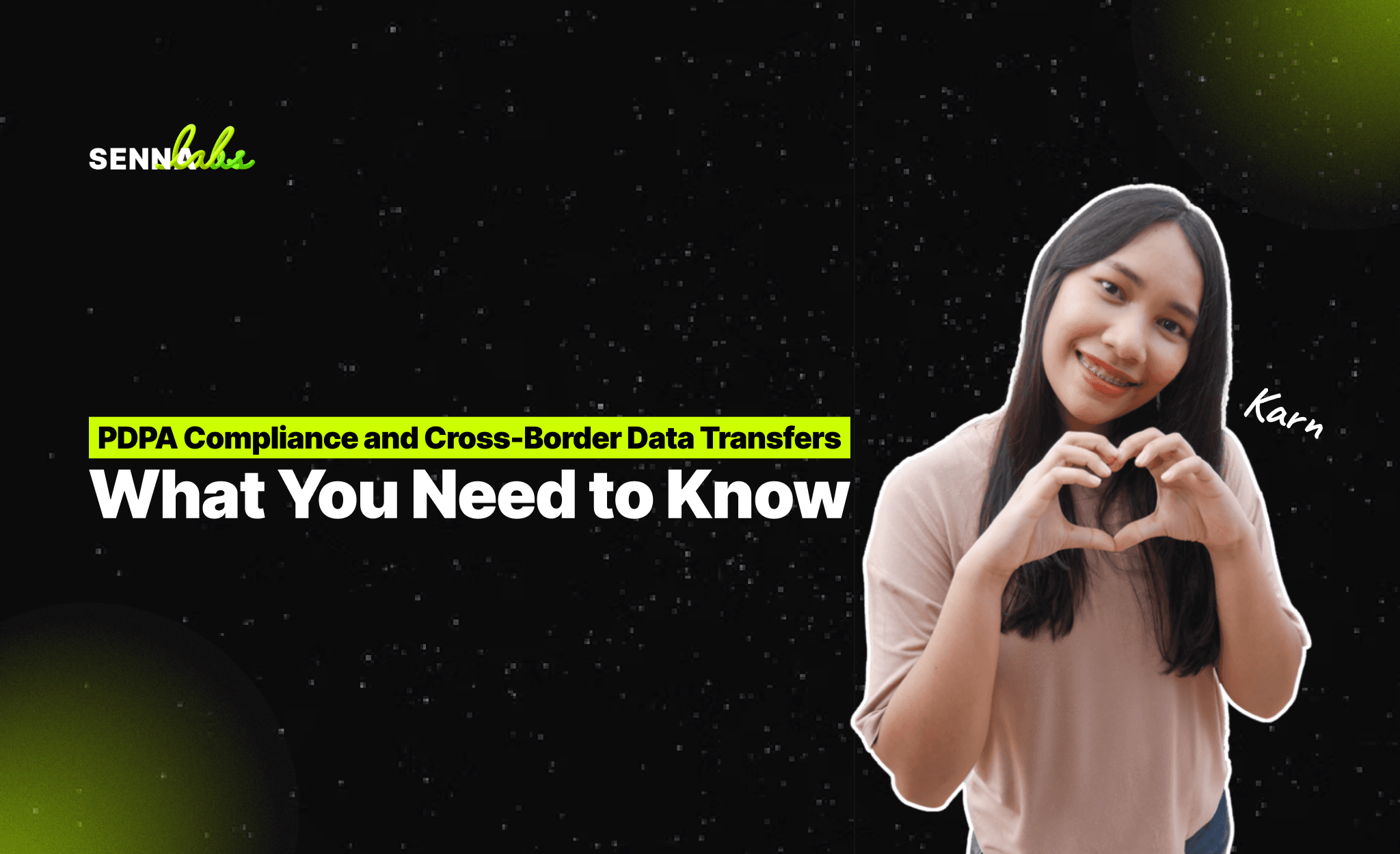PDPA Compliance and Cross-Border Data Transfers: What You Need to Know
Share

In today’s globalized world, businesses often operate across borders, managing personal data from customers, employees, and partners located in various countries. While cross-border data transfers are necessary for efficient business operations, they also come with significant legal responsibilities—particularly concerning the protection of personal data.
The Personal Data Protection Act (PDPA) plays a crucial role in regulating how businesses in countries like Thailand handle personal data, including how they transfer it to other jurisdictions. PDPA compliance is essential to ensure that businesses maintain the privacy and security of personal data while engaging in international operations.
Cross-border data transfers under PDPA require strict adherence to legal protocols, ensuring that personal data remains protected, even when transferred to countries that may not have equivalent data protection regulations. This article will explore the key aspects of PDPA compliance for cross-border data transfers and offer practical guidance on how businesses can navigate these requirements effectively. We will also examine a real-world use case of a global tech company that established PDPA-compliant protocols to enable seamless international data transfers.

What Are Cross-Border Data Transfers?
Cross-border data transfers occur when personal data is transferred from one country to another. This transfer can take place between different offices of the same company, between a company and a third-party service provider, or between business partners operating in different countries. Common examples of cross-border data transfers include:
-
Cloud Storage: Companies store personal data in cloud servers located in different countries.
-
Outsourcing: Personal data is shared with third-party vendors or service providers in other regions for processing, customer support, or analytics.
-
International Transactions: Businesses transfer personal data between international offices to facilitate global operations, such as employee management, financial transactions, or supply chain management.
While cross-border data transfers are essential for global business operations, they also raise concerns about privacy, security, and compliance with data protection laws. Under PDPA, businesses must ensure that any transfer of personal data to another country is done in a manner that protects the rights of the individuals whose data is being transferred.
PDPA and Cross-Border Data Transfers: Key Regulations
PDPA includes specific provisions governing cross-border data transfers to ensure that personal data remains protected, even when it is moved to countries outside the jurisdiction. These provisions are designed to safeguard the privacy rights of individuals and minimize the risks associated with transferring data to countries that may not have robust data protection laws.
Here are the key requirements that businesses must follow when transferring personal data across borders under PDPA:
1. Adequate Level of Data Protection
Under PDPA, businesses are only permitted to transfer personal data to countries that provide an adequate level of data protection. This means that the recipient country must have laws or regulatory frameworks in place that offer comparable protection to the personal data being transferred.
If the recipient country does not meet this adequacy requirement, the business must implement additional safeguards, such as contractual agreements or binding corporate rules, to ensure that the data is protected at the same level as it would be under PDPA.
2. Obtaining Explicit Consent
Before transferring personal data to another country, businesses must obtain explicit consent from the individuals whose data is being transferred. The consent must be informed, meaning that individuals should be fully aware of the purpose of the transfer, the destination of the data, and any potential risks associated with the transfer.
It is important for businesses to provide clear and transparent information to individuals regarding how their data will be used, processed, and protected once it leaves the country.
3. Data Protection Agreements
To ensure that personal data remains secure during cross-border transfers, businesses must enter into data protection agreements with the receiving entity. These agreements should outline the responsibilities of both parties in terms of data security, confidentiality, and compliance with PDPA. The agreements should also specify the legal basis for the transfer and the measures that will be taken to safeguard the data.
For example, if a company is transferring personal data to a third-party vendor located overseas for processing, a data protection agreement can help ensure that the vendor adheres to PDPA’s standards for data security and privacy.
4. Safeguards for Data Transfers
In situations where personal data is being transferred to a country that does not provide an adequate level of data protection, businesses must implement appropriate safeguards to protect the data. These safeguards can include:
-
Standard Contractual Clauses (SCCs): Legal contracts that obligate the receiving party to provide the same level of data protection as required under PDPA.
-
Binding Corporate Rules (BCRs): Internal policies used by multinational companies to regulate data transfers within the same corporate group, ensuring that all entities comply with PDPA.
-
Data Encryption: Using encryption technologies to protect personal data during transit and storage to prevent unauthorized access.
By implementing these safeguards, businesses can ensure that personal data remains secure and protected, even when transferred to countries with less stringent data protection laws.
5. Data Breach Notification
PDPA requires businesses to report any data breaches to the relevant authorities and affected individuals in a timely manner. This requirement also applies to cross-border data transfers. If a data breach occurs while personal data is being transferred or processed in another country, the business must notify the appropriate authorities and take steps to mitigate the damage caused by the breach.
Ensuring that there is a clear plan in place for data breach notification is essential for maintaining PDPA compliance during cross-border data transfers.
Practical Steps for PDPA-Compliant Cross-Border Data Transfers
To facilitate cross-border data transfers while staying compliant with PDPA, businesses must take several proactive steps. Below are some practical strategies for managing cross-border data transfers in accordance with PDPA regulations:
1. Conduct a Data Transfer Impact Assessment
Before transferring personal data to another country, businesses should conduct a data transfer impact assessment. This assessment evaluates the legal, regulatory, and security risks associated with the transfer and helps determine whether the recipient country provides an adequate level of data protection.
The assessment should consider factors such as:
-
The nature of the personal data being transferred.
-
The purpose of the transfer.
-
The legal framework in the recipient country.
-
The security measures in place to protect the data during and after the transfer.
By conducting a thorough impact assessment, businesses can make informed decisions about whether to proceed with the transfer and what additional safeguards may be necessary.
2. Obtain Informed Consent from Individuals
To ensure compliance with PDPA, businesses must obtain informed consent from individuals before transferring their personal data across borders. This requires providing individuals with clear and concise information about the purpose of the transfer, the destination country, and any potential risks involved.
Businesses should also offer individuals the option to withdraw their consent at any time, allowing them to maintain control over their personal data.
3. Use Data Encryption and Secure Channels
When transferring personal data across borders, businesses should use data encryption to protect the data from unauthorized access. Encryption ensures that even if the data is intercepted during the transfer, it cannot be read or used without the decryption key.
Additionally, businesses should use secure transfer channels, such as virtual private networks (VPNs) or secure file transfer protocols (SFTP), to further protect the data during transit.
4. Establish Data Protection Agreements
To protect personal data during cross-border transfers, businesses must establish data protection agreements with the receiving entity. These agreements should outline the responsibilities of both parties, including the implementation of data protection measures and compliance with PDPA.
The agreements should also specify the legal basis for the transfer and include provisions for data breach notification, data retention, and dispute resolution.
5. Monitor and Audit Data Transfers
Once personal data has been transferred to another country, businesses must continue to monitor and audit the transfer process to ensure compliance with PDPA. This includes regularly reviewing the security measures in place, conducting audits of the receiving entity’s data protection practices, and ensuring that any changes in the legal framework of the recipient country are taken into account.
By monitoring and auditing data transfers, businesses can identify and address any potential risks or compliance issues before they lead to data breaches or legal penalties.
Use Case: A Global Tech Company’s PDPA-Compliant Cross-Border Data Transfers
To illustrate how PDPA compliance can be successfully managed in the context of cross-border data transfers, let’s look at a real-world example of a global tech company operating in multiple countries.
The Problem:
The company needed to transfer large volumes of personal data between its offices in different countries for operational purposes, including customer support, financial transactions, and marketing activities. However, some of the countries involved did not have robust data protection laws, raising concerns about the security of the data being transferred.
The Solution:
To address these concerns, the company implemented several key measures to ensure PDPA compliance for its cross-border data transfers:
-
Data Transfer Impact Assessment: The company conducted a comprehensive assessment of the legal and security risks associated with transferring data to each country. This assessment helped determine which countries provided an adequate level of data protection and where additional safeguards were needed.
-
Standard Contractual Clauses (SCCs): For transfers to countries with less stringent data protection laws, the company used standard contractual clauses to ensure that the receiving entity agreed to protect personal data in accordance with PDPA standards.
-
Encryption: All personal data transferred across borders was encrypted both in transit and at rest, ensuring that even if the data was intercepted, it could not be accessed without authorization.
-
Consent Management: The company updated its consent management processes, ensuring that all individuals whose data was being transferred had provided explicit, informed consent.
The Results:
By establishing proper PDPA-compliant protocols for cross-border data transfers, the company was able to continue its international operations without legal risks. The use of encryption and contractual safeguards ensured that personal data remained protected, while obtaining explicit consent helped maintain customer trust.
Conclusion
Cross-border data transfers are a critical component of modern business operations, but they come with significant legal and regulatory responsibilities. Under PDPA, businesses must ensure that personal data is transferred securely and that the rights of individuals are protected, even when their data is sent to other countries.
By following best practices such as conducting data transfer impact assessments, obtaining informed consent, using encryption, and establishing data protection agreements, businesses can navigate the complexities of cross-border data transfers while maintaining PDPA compliance.
As global operations continue to expand, businesses must remain vigilant in their approach to data protection and privacy, ensuring that they meet both their legal obligations and the expectations of their customers.

Share
